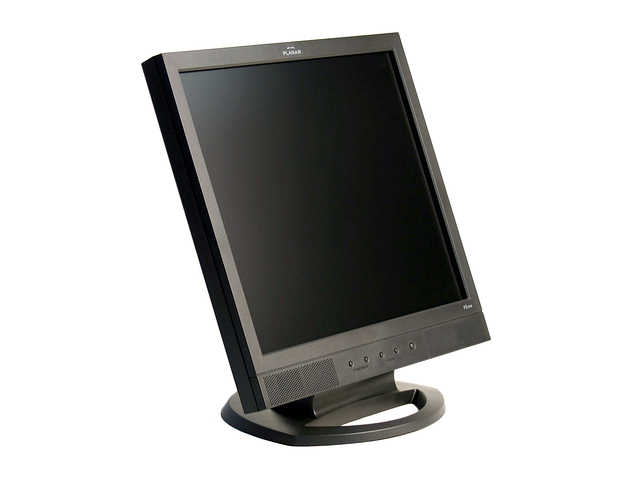A Guide to Choosing the Right 19" LCD Monitor - 7 Models Reviewed
by Kristopher Kubicki on November 30, 2004 12:04 AM EST- Posted in
- Displays
Planar PE191M
Planar is another company that we have been following for a long time. Although not as successful as ViewSonic, Planar certainly has made waves in the past by taking some of the best performing designs and panels and rebranding them under the Planar label. We grabbed another entry level monitor for our roundup and we weren't disappointed.
Looks on this monitor were, again, very basic. The monitor comes with some adjustable functionality along the y-axis, but remains largely stationary. Specifications for the monitor are also mediocre.
| Planar PE191M | |
| LCD | 19" SXGA LCD (Active Matrix) pixel pitch: 0.294mm Anti-glare coating |
| Scanning Frequency | Horizontal: 31-80kHz Vertical: 56-76Hz |
| Response Time | 25ms (Typical) |
| Contrast Ratio | 600:1 (Typical) |
| Compatibility | 1280 x 1024 (Native) |
| Brightness | 250 cd/m2 |
| Viewing Angle | 170 / 170 (Horizontal / Vertical) |
| Warranty | 3 years parts and labor |
| Interface | DVI 15-pin D-sub |
Unfortunately, our Planar came with a few stuck pixels. We tried to rub these pixels out with a Q-Tip, but unfortunately, to no avail. Past Planar LCDs that we have bought for the lab are of very good quality, and it seems that this unit was probably just a fluke.
The PE191M adds to our roundup nicely with average response time, average luminance and average contrast ratios. Even the user interface was fairly average. Planar didn't get anything wrong in the OSD, but it didn't dazzle us.











97 Comments
View All Comments
nullpointerus - Friday, December 3, 2004 - link
So you mean that only _some_ LCD's with that resolution are physically 5:4? LOL, I just couldn't resist it. Sorry I missed your previous post!GOSHARKS - Thursday, December 2, 2004 - link
As I had previously stated (#61,62) - ALL computer LCD's with a resolution of 1280x1024 are PHYSCIALLY 5:4. You will not find a 1280x1024 LCD on the market that is physically 4:3. Kristopher Kubicki really needs to address this in an amendment to his article.nullpointerus - Thursday, December 2, 2004 - link
Keep in mind now that most cards are dual-capable, you could keep your CRT for games and get the LCD for word processing - to decrease eye strain. Not only that, but you could watch TV on the CRT while you're working, or keep two documents visible at the same time, etc.archcommus87 - Thursday, December 2, 2004 - link
Thanks for the info.That's a major turn off for any LCD for me, then. I wouldn't mind running my desktop in 1280x1024 if the monitor itself had a 5:4 ratio, but having to scale my games or run them in a smaller screen would annoy me. Right now I run HL2 in 1280x960 plenty smoothly, but I won't necessarily ALWAYS be able to run the newest games in that high of a resolution.
nullpointerus - Thursday, December 2, 2004 - link
Oh, I might also have mentioned why LCD's are different than CRTs.A LCD produces its image via millions of fixed-size, fixed-position cells that are manipulated with some kind of electrical charge to produce colors which collectively form an image. When the image size isn't exactly the same size as the number of cells, some algorithm has to be applied to scale the image up/down before it can be displayed. There's no physical distortion, but you may get stuck pixels, gamma problems, and streaking.
A CRT produces its image via an electron gun which continually blasts the screen with lines of colors (basically) y*r times per second, where y is the vertical resolution and r is the vertical refresh rate. The size, shape, etc. of these lines are configurable so they can be very easily stretched and manipulated without by changing the focus and interval of the beams. So there's no scaling algorithm per se, but then again you get convergence problems (i.e. where the RGB beams go out of sync with one another), physical distortions (i.e. rounded/skewed/pincushioned image).
That's why LCDs have a "native" resolution while CRTs just have a kind of a maximum firing rate which is usually referred to in terms of a "pixel clock." So in a sense you could say that all of a CRT's supported resolutions are "native."
nullpointerus - Thursday, December 2, 2004 - link
archcommus87:1. It depends on the LCD in question, methinks. Some searching for specifications by the model number of the LCD that you are searching for will usually turn up its aspect ratio. Try to corroborate information from several sources (especially the manufacturer's website if possible) since the stores can get the specs wrong.
2. LCDs run in their native resolution. If that's 1280x1024, it will always "run in" 1280x1024 no matter what resolution your video card is feeding it the video data. There are several ways that lower-than-native resolutions can be handled, depending on your video card's drivers.
AFAIK, the default way is to simply use monitor scaling. For example, if you run a game at 800x600, your flat panel will extrapolate this up into an 1280x1024 image, which makes it look rather blurry. Scaled graphics will probably just look "different," but scaled text will appear fuzzy.
There's also cropping, which will just use the center 800x600 pixels for example and set the others to black. So you get a smaller picture than if you had let the monitor scale it up, but on the other hand it will also be clearer. This might also be called "centering."
IIRC, nVidia has more options in this respect than ATI, but that might depend on the model of your card as well. Maybe look in your video driver help files or ask around to see what your video card supports.
archcommus87 - Thursday, December 2, 2004 - link
No one has provided a clear answer on this, can someone please do so?We know 1280x1024 is 5:4. So are the LCDs actually 5:4 in physical size or are they 4:3 like a CRT? I keep hear differeing opinions. Or is each brand different?
Second, how do LCDs respond when you change the resolution to something other than native? Does everything look garbled and crappy or is it okay as long as you keep your ratio? The reason I ask is because if I had a 19" LCD running at 1280x1024 resolution, I don't think I'd *always* want to run my games at that high of a res.
comomolo - Thursday, December 2, 2004 - link
Hey, Anandtech, I usually trust your reviews, but should I read further when you state that 17 and 19 inches monitors put 5:4 aspect ratios into 4:3 boxes? Or when you compare CRTs capable of much higher resolution than that of the 17 and 19 inches LCDs. An apples to apples comparison would show you LCDs are still much more expensive than comparable CRTs.Toadster - Wednesday, December 1, 2004 - link
why no review of the DELL 1905? i mean, DELL reigned in the 20+ review why not the 19?deathwalker - Wednesday, December 1, 2004 - link
The Dell 2001FP is only $799 for those that don't shop smart..I bought mine several weeks ago and only paid $639 for it. I love it and have no regrets even after this article. Im runnin a 1600x1200 desktop..something none of these other monitors can do.